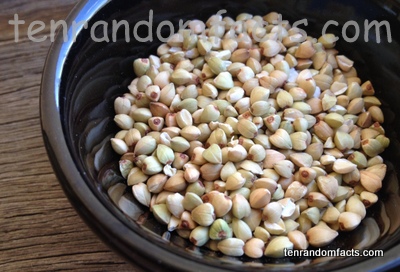Buckwheat is not wheat but instead a wheat alternative.
- Buckwheat is a seed grain that is obtained from the plant with the scientific name Fagopyrum esculentum, and is classified as a pseudocereal, as it is not a species of grass.
- ‘Buckwheat’ is also known as ‘beech wheat’, and this name is a reference to the similar triangular shaped appearance it has to beech nuts that are significantly larger, and its common use as a wheat replacement.
- Buckwheat is not related to wheat, instead it comes from the family Polygonaceae, the family of knotweed, that rhubarb also belongs to.
- ‘Buckwheat’ s comes from the word ‘boecweite’ that means ‘beech wheat’ in Middle Dutch, and when the seed is roasted, it is known as ‘kasha’.
- In 2011, Russia was the leading producer of buckwheat, with 800,380 tonnes (882,000 tons), China with 720,000 tonnes (793,700 tons) and Ukraine boasting 281,600 tonnes (310,400 tons).
- The outer buckwheat layer is typically a dark tan when roasted, or light green or brown in colour when raw, while the inner starch is coloured white, and is approximately 3 to 4 millimetres (0.12 to 0.16 inch) in diameter and approximately 5 millimetres tall.
- Buckwheat can be eaten raw or roasted, and is commonly ground into flour, which in turn is used in pancakes, noodles, bread and porridge; although some people are allergic to it, causing a rash, and anaphylaxis cases have occurred.
- Buckwheat is a grain that does not contain wheat or gluten, and therefore is a common replacement for those with coeliac disease, or who are intolerant or have an allergy to wheat.
- A buckwheat seed is called a ‘groat’, and its triangular shape has led to unique equipment to hull the seed.
- Buckwheat is very high in fibre, niacin, riboflavin, copper, magnesium, phosphorous and manganese.
Bibliography:
Buckwheat, 2014, The World’s Healthiest Foods, http://www.whfoods.com/genpage.php?tname=foodspice&dbid=11
Buckwheat, 2014, Wikipedia, http://en.wikipedia.org/wiki/Buckwheat
Murray, J, What is Buckwheat? Buckwheat Defined, 2014, About Food, http://vegetarian.about.com/od/glossary/a/What-Is-Buckwheat.htm






